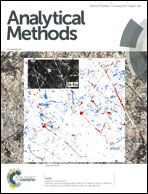A label-free SERRS-based nanosensor for ultrasensitive detection of mercury ions in drinking water and wastewater effluent†
Abstract
Precisely probing mercury ions (Hg2+) is of essential importance to human health and environmental protection. Although numerous methods have been developed to detect Hg2+ in water, challenges still remain for rapid, accurate, and reliable detection of Hg2+ at the ppt level. In this study, a novel label-free Fe3O4@Ag based surface-enhanced Raman resonance scattering (SERRS) nanosensor has been developed for ultrasensitive and highly selective detection of Hg2+. The detection mechanism is on the basis of competitive binding interaction of Hg2+ and malachite green (MG) with nano-sliver on Fe3O4@Ag magnetic beads (MBs). In the absence of Hg2+, the Raman signal intensity of MG is significantly enhanced by the nano-silver when MG adsorbs on the nano-silver surface via one nitrogen atom. In the presence of Hg2+, the redox reaction occurring between zero-valent nano-silver and Hg2+ leads to the formation of a Ag/Hg amalgam at the Fe3O4@Ag surface, which prevents the adsorption of MG on the nano-silver surface. Thereby, the SERRS signal intensity of MG proportionally decreased with increasing Hg2+ concentration. Under optimized conditions, the proposed label-free nanosensor showed unprecedented Hg2+ detection sensitivity of 10 pM (2 ppt) with excellent selectivity. This simple sensor system can be directly applied for an inexpensive and easy-to-use monitoring method of Hg2+ in drinking water and wastewater treatment effluents that contains complicated organic and inorganic interferents.


 Please wait while we load your content...
Please wait while we load your content...